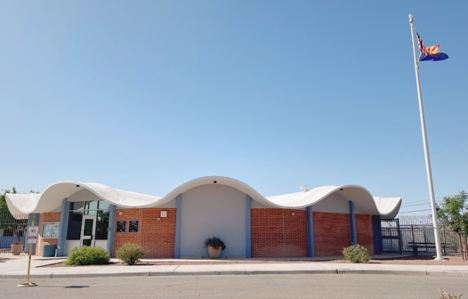Flowing Wells Neighborhood Profile
Flowing Wells Neighborhood by Marlene Avelino
Flowing Wells neighborhood is bounded on the North by Ina Road and Grant Road to the South with the Santa Cruz River to the West and Fairview to the East, about half of the neighborhood is outside of the city, represented by Supervisor Sharon Bronson.

Early Flowing Wells area canal, 1890
“The area was named after the bubbling water from sunken pipes at the base of Sentinel Peak ("A" Mountain) by Warren Allison. Around 1895, Allison bought 500 acres of uncultivated land about three miles northwest of downtown Tucson. He and a sturdy team dug a canal, the Allison Ditch, from his wellfield to his land, called the Flowing Wells Ranch, to grow alfalfa, hay, watermelons, and cantaloupes,” an excerpt from Kevin and Marie Daily’s book, Flowing Wells.
In 1922 this water source was formally established as a water utility, the Flowing Wells Irrigation District, and still serves modern day residents between Miracle Mile to Rillito River and the I-10 to Fairview Ave. The utility serves more than 16,000 people, with nine active wells pumping water from the Tucson Basin aquifer at 205 feet to 400 feet deep.

The eye-catching Walter Douglas Elementary School with it's dramatic, fluted thin-shelled concrete roofs, built in 1963, designed by architect John A. Shaver
Flowing Wells has a public library branch and their own school district. Many residents credit the school system for the family feel to the neighborhood. “I love this area because the Flowing Wells School District has created a family atmosphere for the area. We seem to know each other because our six elementary schools feed into one Jr High and one traditional high school and one alternative school,” said Kevin Daily, President of the Flowing Wells Neighborhood Association and Community Coalition.
Flowing Wells has a very active neighborhood association. Organized in 1995, community members got together with general goals of installing streetlights, reducing street flooding, and cleaning up the neighborhood. They expanded their ambitions and in 2000, the association partnered with several organizations to develop and implement a 5-year Neighborhood Revitalization Strategy Plan. The plan was approved by the U.S. Dept. of Housing and Urban Development and the Board of Supervisors in 2001, and has been extended every 5 years.
The association has been involved in the planning and execution of Flowing Wells Park, Curtis Neighborhood Park, Ellie Towne Community Center, the public library, a health/dental center, a new Women’s, Infants, and Children (WIC) Center, the Pima County I'm Home housing project, the Pima County Get in the Zone (open storage and unregistered vehicle project), and the development of the Flowing Wells Business Corridor. The association meets every third Thursday of the month at 6 pm. They are currently hosting hybrid meetings; you can join via zoom or in person at the Ellie Towne Community Center.
Flowing Wells has an active Crime Watch Association headed up by Nicole Snook, who is still considered a newbie to the neighborhood since she only just moved in in 2002. Most neighbors have been in their homes since they were built in the 50s. “As a neighborhood group, we have learned to get to know each other by name, not just by face or the car we drive. We've learned about each other's pets so that if they get out, we can help get them home safely. We have coordinated TNR (Trap-Neuter-Release) for our community cats. We have found out what assets we have and the needs we have so that we can help match neighbor with neighbor when it comes to getting things done. We have cleaned up the area to make it safer and friendlier. We've donated to neighbors in need and helped students fundraise for their schools,” says Nicole Snook.

One of Flowing Wells’ most beloved Mexican food spots, Aqui Con El Nene
Another neighbor, Curt Brill, adds, “We began our pursuit of the neighborhood watch to make our neighborhood cleaner, safer and friendlier. The friendlier part seems to me to be the part where the real rewards are felt. It is measured by a shared sense of community where we can walk down the street and are greeted by name by our neighbors. Our meetings were initially filled with grumblings of what was wrong. Now little by little as we participate with each other, the interactions are more small moments of chatting with each other. I now get messages from neighbors to come pick up some homemade tamales or to come pick roses from their abundant rose bushes. We get to know each other as people, as individuals.”
Crime Watch meets every third Saturday at 4 pm in hybrid meetings, in person at Old Times Kafe and on zoom.